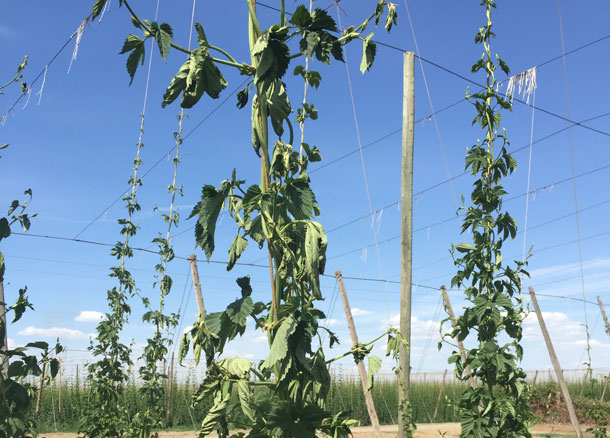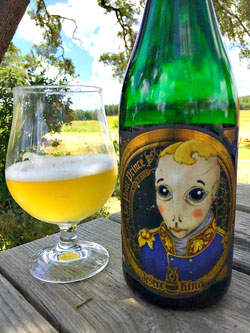If you haven’t memorized the details within the June Hop Acreage Report you might want to read that first, but now we have the world Hop Market and Crop Development Report from the Barth-Haas Group, the world’s largest hop broker.
So here’s what’s new since last week:
– “Worldwide hop acreage surpasses 50.000 ha (123,500 acres) for the first time since 2010; continued shift towards aroma/flavour in the US and more varietal changes in Germany. Favourable growing conditions in Europe to date; some concern about unusually high temperatures in the Yakima Valley in early June coupled with rolling water rationing in some locations.”
In fact, mandatory water rationing in the Wapato Irrigation District means a good chunk of hops receive water for 10 days, then don’t for 5. A friend sent me this photo of plants after three days without water at 90 degrees (Fahrenheit). Write your own caption. I like, “Beer is an agricultural product.”

More from the report: “Overall, at this stage, the crop appears to be average. The unusually hot days and warm nights have moved the plants well ahead of a normal schedule. Some growers have been struggling to maintain sufficient labor force to complete certain tasks on time and there are some concerns about water availability in junior water districts, which have curtailed deliveries at a time when temperatures have spiked. The excessive heat has increased spider mite populations. Control measures are being applied. Some powdery mildew is showing at this time. Fungicide applications are being applied for control.”
– As promised, German growers have planted more of the three new varieties with “New World” aroma character that so many brewers (and presumably drinkers) want. Mandarina Bavaria acreage is up 109%, Hallertau Blanc 127%, Huell Melon 82%. Of course, it will be 2017 before rhizomes planted this year produce a full crop.
This news is a drag: “The structural change among German hop growers continues: 21 operations ceased after the 2014 harvest leaving 1.171 active hop farms for 2015. The average farm size has increased to 15,2 ha (up from 8,5 ha in 2000).”
– “The Czech Republic reports a modest increase of 3.5% to a total of 4.617 ha. Slovenia increases by 110 ha, mainly in the Celeia variety, to reach 1.406 ha. Poland also expands acreage by some 100 ha to 1.510 ha. China reduces hop acreage by 255 ha and drops to 2.400 ha.”
– The market outlook: “2015 is fully contracted out in both the fine aroma and flavour categories. The availability of spot quantities will depend on the outcome of the crop. The market is considerably softer in standard aroma varieties (mainly Perle and Hallertau Tradition) as well as high alpha hops where supply and demand are more or less in balance.”
And: “The 2015 spot market is set to be a challenging one again for the industry.”
In which case you could be reading a lot soon about soaring hop prices. Those won’t affect brewers who have contracts, so short term are not an excuse for big time increases in hop prices. Long term, some sorting out to do.
 Jack Perdue has announced the topic for The Session #101 will be
Jack Perdue has announced the topic for The Session #101 will be  Pardon the length, but I’m posting the entirety of the email that Jester King Brewery sent out yesterday. Thoughts after the message.
Pardon the length, but I’m posting the entirety of the email that Jester King Brewery sent out yesterday. Thoughts after the message.